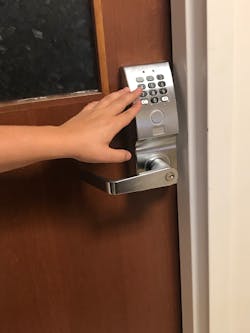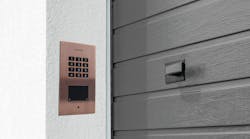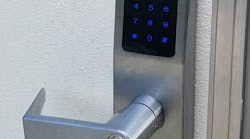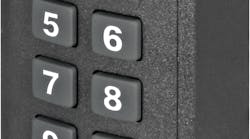Glitter and glamor sells, especially when it’s technology related. In terms of the Electronic Lock (EL), we’re seeing more and more of them in residential spaces. In their fundamental form, an EL offers key-free entry, allowing homeowners to enter without fiddling with a keyring full of keys. Entry in its base form is through a PIN (Personal Identification Number), which is entered through a series of buttons (see Figure 1).
There are two basic categories of electronic locks on the market today: 1) the Electronic Mechanical Lock (EML), and 2) the Smart Electronic Lock (SEL).
Installation of a basic EML is straightforward. Because it’s basically mechanical, the initial portion of the installation is similar to a common, ordinary cylindrical or mortise mechanical lock.
Simple EML’s have no connection with the outside world, as is the case with Internet connectivity. There also is no connection possible with a mobile device of any kind. They require programming for one to 20 PINs, depending on the make and model -- which are usually 6 to 10 digits long. Programming may also include the assignment of a time range during which authorized users can access a door.
SELs are more advanced in that they require more programming, but the installation itself is almost identical to the EML. To read about the basic differences between them, refer to the sidebar on page XX.
A Growth Market
The popularity of the SEL in residential is growing with each passing day, and that’s why it’s important that you, as a locksmith, be part of that growth.
For example, according to Parks Associates of Addison, TX, the SEL market is expected to reach or exceed a whopping $352 million in 2023. Parks says that one in four U.S. broadband households (homes with Internet) intend to purchase a smart door lock in the next 12 months. One giant reason for this includes significant price reductions.
“35 percent of U.S. broadband households find smart door locks to be affordable,” says Parks. “The average number of smart locks purchased in 2017 was 1.2 devices, with the majority purchasing just one device.” This will expand the demographics of product owners over the next several years into more early mass-market segments, including households with moderate incomes and smaller homes.
What this means is that more low-to-middle income families will be able to afford them in the future, thus providing you with more opportunities to sell them. Consequently, the number of conventional mechanical locks replaced by SEL’s will steadily dwindle, which theoretically will reduce business for those of us whose focus is primarily on conventional mechanical locks. It’s important that you lead your company into the 21st Century by investing time and money in this growing market. This will assure your company’s future, including your eventual retirement.
Because the SEL is becoming so popular, consumer distribution, such as Home Depot and Lowes, are at the spearhead of a burgeoning DIY market that you should be part of if you have a brick and mortar store/shop. It’s certain with a little advertising that you can sell them over the counter just as you do so many other things.
For the remainder of this Locksmith Ledger story, we’re going to discuss the SEL in all its glory.
Selling Convenience, Lower Cost and Tech
There are three points of discussion you can use when selling SELs.
1. User convenience by way of keyless entry.
Point 1: Keyless entry is a huge attraction for residential homeowners. First is the ability to come and go with greater ease. Without the worry of keys, this can make the home more secure than mechanical locks alone. Latch-key kids that arrive home after school before their parents get home from work is another talking point. Parents who rely on keys know too well what happens when their child forgets to take their key to school with them, or when their key is missing and no one knows for sure whether it was lost or stolen.
Also, picture coming home from the grocery store with two big shopping bags of food. Armed with a traditional key, you must set one of the bags down in order to open the door. With a SEL, you can approach the door with her purse, which contains her Smartphone, and the lock will release.
The second major part of this first talking point is the common use of mobile devices by almost every family member. An ordinary Smartphone becomes an invaluable component in the effort to span the gulf between convenience and security in the home. Unlike a $2 key, the relatively high cost of a Smartphone precludes carelessness with regards to unknowingly misplacing it during the day.
2. Integration of SEL’ with the user’s security and home control system(s)
One of the most compelling arguments on the issue of SEL use is that of integration with the prospective customer’s own alarm and/or home control system(s). Alarm systems can be programmed to include the homeowner’s SEL’s as can their home control system. This is because SEL’s are designed to leverage several different wireless control technologies, among with are BluetoothTM, BluetoothTM Low-Energy (BLE), WiFi, ZWave, ZigBee, and Near Field Communications (NFC).
For more information these wireless technologies, see the following past Locksmith Ledger stories:
Enter The Wireless World of Home Automation: http://bit.ly/2WZICxv
Here’s the Thing about Wireless: http://bit.ly/2Jwn9cw
How to Work With Wireless Technology in Difficult Settings: http://bit.ly/2HUGhO6
3. Use of connective technologies and systems that foster greater convenience for users at the door and when away.
In reality, all three talking points hinge on the fact that more and more homes in the United States are equipped with the Internet and wireless WiFi. This means the homeowner can connect with their alarm system, inside and outside cameras, as well as each SEL in the home from anywhere in the world. This includes the office, gym, or while traveling.
According to the Smart Lock Market Size, Share & Trends Analysis Report, provided by Grand View Research of San Francisco, CA, “Rising adoption of connected home solutions and soaring need to establish connectivity across all electronic devices in users’ houses as a consequence of growing penetration of smart homes are among the key trends escalating market growth. Increasing penetration of smartphones is also fueling the demand for smart locks over the forecast period” (http://bit.ly/2ErmhBW).
From all indications, SEL demand will continue to grow as more consumers learn about the convenience and enhanced security inherent in their use. The question is, will or won’t you become part of this relatively new income stream? If not you, then someone else will.






